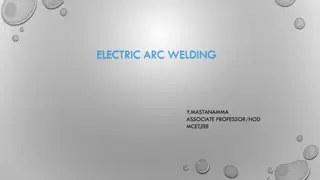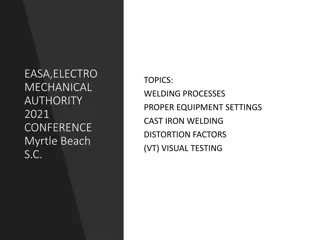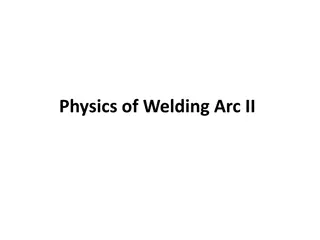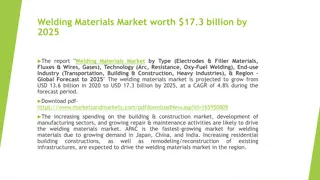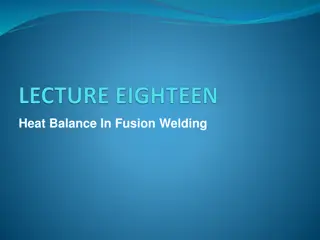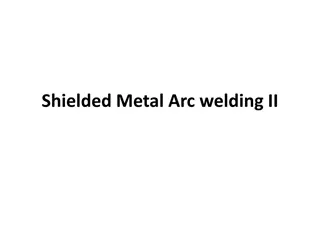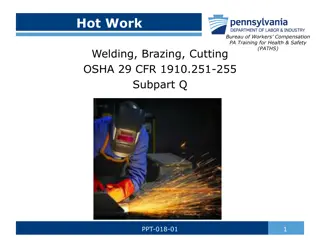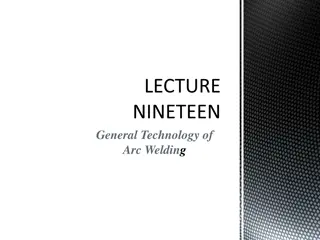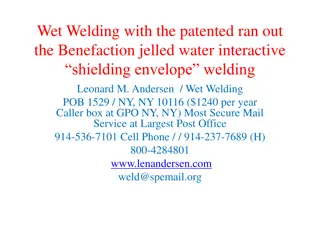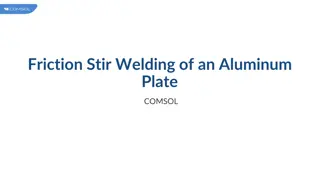Methods of Welding Arc Initiation and Maintenance
This lecture delves into the methods used to initiate and maintain the welding arc, including touch start and field start techniques. It explores the characteristics of the welding arc, temperature distribution, and factors influencing arc behavior. Touch start involves creating a small gap by bringing the electrode into contact with the workpiece, while field start utilizes a high electric field for electron emission. Both methods are crucial for various welding processes, ensuring the stability and efficiency of the arc for successful welding operations.
Download Presentation

Please find below an Image/Link to download the presentation.
The content on the website is provided AS IS for your information and personal use only. It may not be sold, licensed, or shared on other websites without obtaining consent from the author. Download presentation by click this link. If you encounter any issues during the download, it is possible that the publisher has removed the file from their server.
E N D
Presentation Transcript
Lecture 6 Physics of Welding Arc II
Overview This lecture presents: Methods of initiating and maintenance of the welding arc Arc characteristics and temperature distribution in welding arc. Factors affecting the arc characteristics Temperature distribution of welding arc
Arc Initiation Methods to initiate an electric arc in welding processes: -Touch start and -Field start. The first one is used in case of all common welding processes. The later one is preferred in case of automatic welding operations, electrode remains inside the nozzle such us TIG welding
Arc Initiation- Touch start -The electrode is brought in contact with the work piece and then pulled apart to create a very small gap. -Touching of the electrode to the workpiece causes short-circuiting resulting in flow of current which leads to heating, partial melting and even slight evaporation of the metal at the electrode tip.
Arc Initiation- Touch start -Heating of electrode produces few free electrons due to thermal ionization; - - Metal vapours also produces charged particles -Pulling of the electrode a way from the work piece, flow of current starts through these charged particles and for a moment arc is developed. -To use the heat of electric arc for welding , it is necessary that after initiation of arc it must be maintained and stabilized
Arc Initiation-Field Start -High strength electric field (107 V) is applied between electrode and work piece so that electrons are released from cathode (electro- magnetic field emission). -High strength field lead to ejection of electron from cathode spots. -Once the free electrons are available in arc gap, normal potential difference between electrode and work piece ensures flow of charged particles to maintain a welding arc.
Arc Initiation-Field Start -This method is commonly used in mechanized welding processes such as plasma arc and GTAW process where direct contact between electrode and work piece is not preferred.
Arc Initiation-Field Start However, some of the electrons are lost from the arc surface, to the weld pool and surroundings and few electrons combined again with ions. Loss of these electrons must be compensated by generation of new free electrons. In case of direct current (D.C.), magnitude and direction of current does not change with time thus maintaining the flow of electrons and so the arc becomes easy. in case of alternating current (A. C.) both magnitude and direction change with time and for a moment flow of current becomes zero. This makes re-ignition of an electric arc with AC somewhat difficult and therefore it needs attention Two commonly used methods for maintaining the arc initiation in A.C. welding: (1) use of low ionization potential elements in coatings flux and (2) use of low power factor power source(Transformer ).
Arc Initiation-Field Start-AC. Low Ionization Potential Elements -Low ionization potential elements such as potassium, calcium and sodium are added in the flux covering of the electro- de (coating). -These elements release free electrons required for reasonably good electrical conductivity for maintaining welding arc even with small potential difference between electrode and work piece
Maintenance of Arc -Once electric arc is initiated, next step is to maintain it to use the heat generated for welding purpose. For maintaining of the arc two conditions must be fulfilled: (1) heat dissipation rate from the arc, region should be equal to that of heat generated to maintain the temperature of the arc and (2) number of electrons produced should be equal to that of electrons lost to the work piece and surroundings. -An electric arc primarily involves flow of current through the gap between the workpiece and electrode hence there must be sufficient number of charged particles
Arc Characteristic -Welding arc characteristic shows variation in the arc voltage with welding current, where three different regions are observed: 1. Dropping zone, 2. Flat zone 3. Rising zone -Initially at low current when arc is thin, an increase in welding current increases the temperature of arc zone which in turn enhances the number of charged particles in plasma zone of the arc due to thermal ionization and ther-moionic emission of electrons. As a result, electrical conductivity of arc zone increases. Arc voltage decreases with initial increase in welding current in this zone. Arc tends to be stable in this region.
Arc Characteristic -After that increase in current increases the diameter of cylindrical arc that increases the surface area of the arc thus increasing loss of heat from the arc surface. Therefore, no significant rise in arc temperature takes place with increase of current hence arc voltage is not affected appreciably over a range of current in flat zone of the curve. -Further, increase in current increases the resistance to flow of current so arc voltage increases with increase in welding current in rising characteristic zone .
Arc Characteristic -Increase in arc length in general increases arc voltage during welding. However, the extent of increase in arc voltage with increase in arc length varies with process -In general, arc voltage increases with increase in arc length and this is due to increase in resistance to the flow of current due to reduction in charged particle density in arc zones with increase in arc length.
Arc Characteristic -Variation in charged particle density in arc zones related to different arc welding processes such as SMAW, GMAW and GTAW thus one can see the difference in arc voltage vs. arc length relationship for these process. -For example, GTAW process due to tungsten electrode (having high electron emitting capability) results in higher charged particle density in arc region than GMAW and SMAW which in turn leads to lower arc voltage/arc length ratio for GTAW than LMAW & SMAW process.
Temperature of the Arc -In addition to arc voltage and current parameter (governing the power of arc), thermal properties of shielding gases present in arc zone predominantly affect the temperature and its distribution in the arc region. -Thermal conductivity of most of the gases (He, N, Ar) increases with rise in temperature however, this increase is not continuous for some of the gases such as Helium. -Thermal conductivity of base metal/shielding gas governs temperature gradient in the arc region. Reduction in thermal conductivity increases the temperature gradient Therefore, a very rapid decrease in temperature of arc is observed with increase in distance from the axis (center) of the arc
Temperature of the Arc -Maximum temperature is observed at core (along the axis of electrode) of the arc and it decreases rapidly with increase in distance away from the core. -Temperatures in anode and cathode drop zones are generally lower than the plasma region due to cooling effect of electrode/work piece. -Temperature of arc can vary from 5000-30,000K depending upon the current voltage shielding gas and plasma gas. For example, in case of SMAW, temperature of arc is about 6000K while that for TIG/MIG welding arc it is found in range of 20000-25000K.




